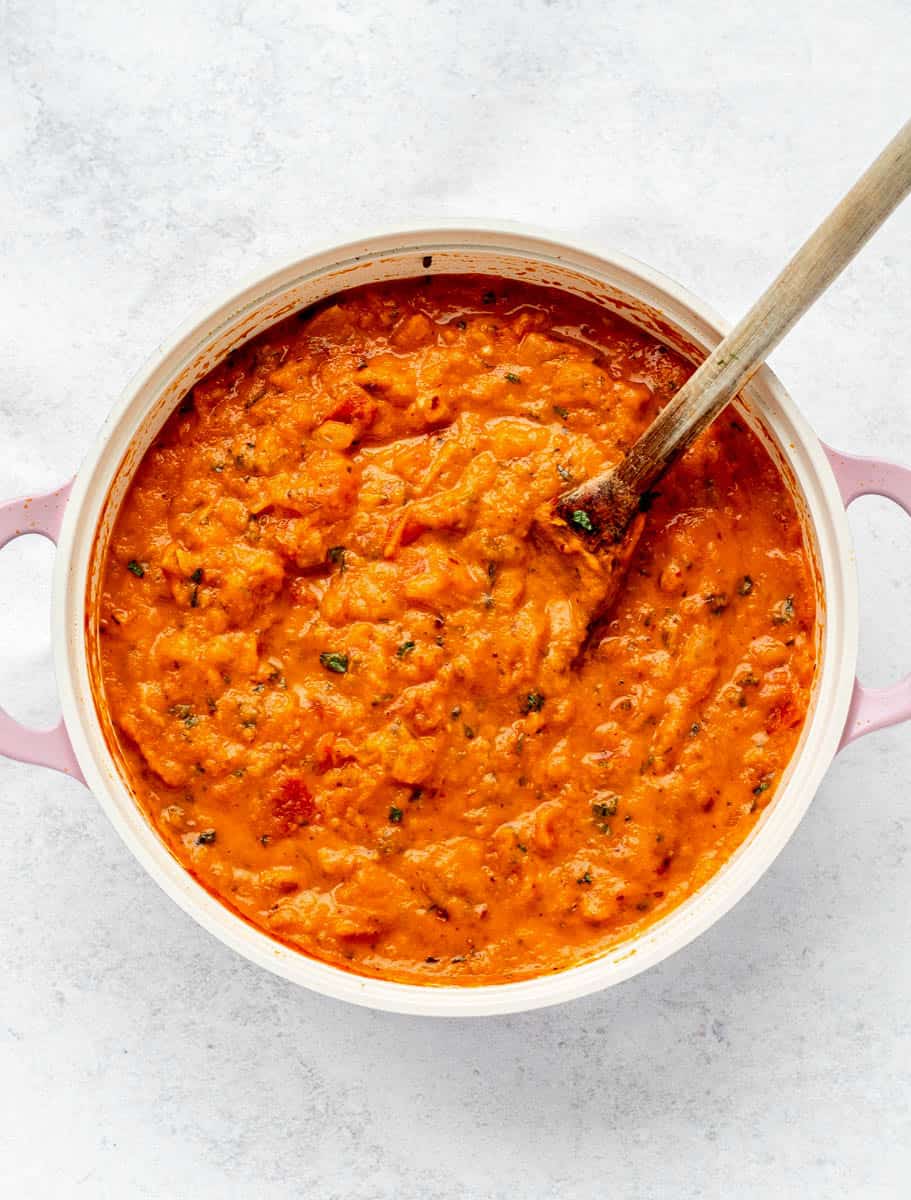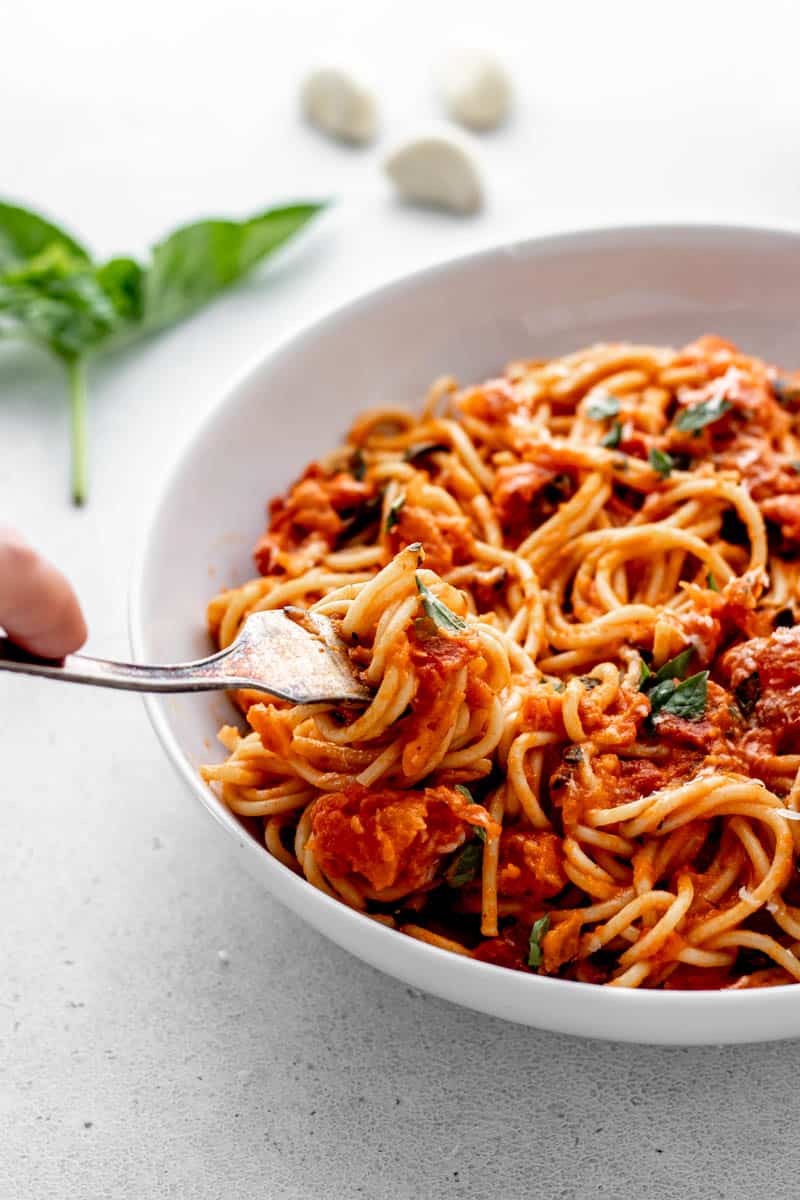This homemade low sodium spaghetti sauce is the perfect lower sodium and sugar-free alternative to store-bought pasta sauce and is so easy to make! Fresh tomatoes, basil, garlic and sun-dried tomatoes fill this authentic Italian-inspired sauce with a mouthwatering flavour and aroma. It’s highly recommended that you make a large batch and freeze it because it won’t last long! {Vegan, gluten-free, low carb & keto-friendly}

Table of Contents
Quick and Easy Homemade Spaghetti Sauce
In our house, we love pasta night. It’s so satisfying, quick and easy to whip together and my husband and kids always devour it. We’re constantly on the hunt for low-sodium pasta sauces, but a good tasting one is so hard to find!
That’s why we’re huge fans of this homemade low sodium spaghetti sauce. It’s one of our all-time favourite sauces to serve over pasta and is perfect for those looking to avoid the processed sauces and minimize their sodium intake.
Don’t let the “low sodium” part fool you though. With the fresh tomatoes, sun-dried tomatoes, fresh herbs and spices, it’s so flavourful and a great healthy alternative to the jarred sauces you buy at the grocery store.
Less sodium and no added sugar is always a winner in my books!
Incredibly rich and delicious, this fresh tomato pasta sauce has such an amazing texture, since it’s perfectly creamy and chunky all at the same time. Plus, you can customize it with whatever add-ins that you like for pretty much the best pasta dish EVER.
With its authentic Italian flavour, this basic meatless sauce recipe is one that even the most novice of home cooks will be able to master. The best part is, it comes together easily in one pot on the stovetop, so even the clean up is a breeze.
After tasting this easy sauce made from scratch, you’ll never want to buy jarred again!
Be sure to try my Lemon Garlic Parmesan Shrimp Pasta and Healthy Vegetarian Pasta Salad too!

Why We Love this Vegetarian Spaghetti Sauce Recipe
- Great for meal prep: Whenever I make this recipe, I always like to make a double batch. It keeps well in the fridge but is freezer-friendly too. Perfect to reheat for a quick and flavour-packed meal!
- Low sodium: On average, a typical store-bought spaghetti sauce contains around 300-500 mg sodium per serving and typically has over 15% of the percent daily value for sodium, which is considered to be on the higher end.
- This homemade spaghetti sauce only has 19 mg of sodium if you don’t add any salt, and around 194 mg per half cup serving if you add 3/4-1 teaspoon of salt (which is what I typically do). Unlike store-bought sauces, you can adjust how much salt is added to suit your taste and dietary needs.
- Simple: DIY spaghetti sauce may sound intimidating, but it’s surprisingly really easy! With a few basic ingredients and one pot, it’s ready to enjoy in 30 minutes with minimal prep required.
Ingredient Notes

- Oil: For cooking. I like to use extra-virgin olive oil for that real Italian flavour. but you can use another type of olive oil, canola, or avocado oil too.
- Onion and garlic: To give the tomato sauce a nice depth of flavour, while providing an extra dose of veggies!
- Fresh tomatoes: This recipe uses both fresh and sun-dried tomatoes. Use regular or organic tomatoes if preferred. De-seed the fresh tomatoes before dicing so that the sauce isn’t too watery.
- Sun-dried tomatoes: The sun-dried tomatoes add a punch of rich flavour when pureed into the sauce. Use pre-sliced sun-dried tomatoes for convenience and easier blending.
- Fresh herbs and spices: Fresh basil, dried oregano, salt, black pepper and red pepper flakes fill this spaghetti sauce with so much mouthwatering flavour! Adjust salt, pepper and red pepper flakes to taste.
How to Make Spaghetti Sauce with Fresh Tomatoes






- Drizzle olive oil into a medium-sized pot. Add the onion, and garlic and stir to combine. Season with a little salt and pepper. Saute over medium high heat for about 5 minutes, or until the onion is soft and translucent.
- Cut the tomatoes into quarters and scoop out the seeds with a spoon. Dice tomatoes into 1-inch cubes. Stir in the diced tomatoes and increase heat to medium-high until it starts to boil.
- When the mixture boils, reduce the heat to medium and simmer for about 15 minutes, uncovered, until most of the liquid evaporates. Monitor closely, reducing to low heat if necessary, and stirring often.
- Add sun-dried tomatoes into a blender or food processor along with two ladles of the tomato mixture. Blend until mostly smooth.
- Stir the tomato puree back into the tomato sauce in the pot.
- Stir in the minced basil, oregano, salt, pepper, and red pepper flakes. Continue cooking until mixture has reached desired thickness and then remove from heat. Serve over cooked pasta with desired add-ins.
Keep scrolling to the recipe card for the full sauce recipe!

Recipe Tips for the best spaghetti sauce:
- Use fresh ripe tomatoes: To ensure the best flavour. They should be bright red; not green. I used about 8 cups of diced fresh tomatoes.
- Remove all of the seeds from tomatoes: This prevents the sauce from being too “soupy.”
- To save time: If you want to save on time or don’t have any fresh tomatoes, you can also use drained no salt-added canned diced tomatoes.
- Don’t overfill the blender: The hot liquid could explode out of the blender and may result in a burn (and big a mess in the kitchen)!
- Sauce consistency: Adapt the amount of tomato mixture that you add to the blender according to how thick and smooth you like your sauce. I blended about 2 heaping soup ladles of the tomato mixture with the sun-dried tomatoes and found that it had the perfect consistency.
- For a smoother sauce: If you don’t like chunks of tomato in your sauce, puree all of the sauce in the blender, rather than just a couple of ladles for a smoother texture.
- Nutritional info: This recipe makes about 5 cups of sauce total or ten 1/2 cup servings. The nutrition facts are based on a 1/2 cup serving of sauce with no salt added. The sodium quantity will vary depending on how much salt you choose to add.

Storage and Reheating Guidelines
Refrigerator: This tomato pasta sauce can be stored in the fridge for up to 4-5 days. Let it cool fully before storing in a jar or airtight container.
Freezer: Once the sauce is fully cooled, transfer it into a freezer-safe container. These Souper Cubes are great if you want to freeze the sauce in smaller portions. It will keep well frozen for up to 6 months. Defrost it in the fridge or for a couple of hours at room temperature before reheating.
Reheating: Reheat the spaghetti sauce in a pot on the stovetop until heated through.
Recipe FAQs
These two classic Italian pasta sauces are very similar and both are tomato based. The primary difference is that spaghetti sauce tends to have sautéed veggies or meat which adds a deeper flavour.
Most store-bought sauces and traditional recipes are naturally gluten-free. That being said, if you have an intolerance, you should always carefully check the label for ingredients containing gluten. This recipe is gluten-free.
Many store-bought and homemade pasta sauces contain a great deal of sodium and sugar, so they aren’t always as nutritious as you might think. This made-from-scratch spaghetti sauce has no added sugar and a much smaller amount of sodium compared to other recipes out there. Plus, it contains heart healthy fats, vitamin C, beta carotene and the antioxidant lycopene, which may help protect against heart disease (source).
Yes! This sauce is great for freezing. It will keep well frozen for up to 6 months and can be thawed in the fridge or at room temperature. As with all hot foods, let the sauce cool fully before freezing. If it goes in hot, it can affect the overall temperature in your freezer.
This low salt sauce may be appropriate for individuals who require a lower sodium diet such as those with high blood pressure, chronic kidney disease, babies under the age of one, or simply families looking to minimize their intake of processed foods.
That being said, if you have a medical condition, it’s always best to seek professional medical advice prior to implementing any major dietary changes.

Serving suggestions
Serve this low sodium spaghetti sauce over spaghetti noodles or sub in your favourite pasta. I found that 12 ounces of dry spaghetti (about 3/4 of the box) was a good amount to cook and serve with this sauce recipe.
You can serve the sauce and pasta as is, or feel free to customize the sauce with your favourite add-ins. It’s also delicious topped with additional fresh basil and freshly grated parmesan cheese!
Try mixing in any of the following:
Protein:
- Ground beef or ground sausage
- Ground chicken or turkey
- Meatballs
- Cooked sliced sausage
- Cooked lentils
- Cooked shrimp
- Cooked sliced chicken
Vegetables:
- Zucchini
- Carrots
- Peppers
- Mushrooms
- Spinach
Other uses for spaghetti sauce
If you’re looking for some creative ways to put this sauce to use, here are some ideas.
- Mix it in with spaghetti or your favourite pasta
- Serve it over zucchini noodles or “zoodles” for a lower carb option
- Serve it over spaghetti squash with meatballs
- Use it as a pizza sauce
- Use it for parmesan chicken or these chicken parmesan burgers
Recipe variations
This low sodium spaghetti sauce recipe is pretty delicious as is, but it’s also easy to adapt to suit your tastes.
- Add more veggies: Saute some bell peppers and mushrooms with the onion for a more veggie based sauce.
- Add meat: For a heartier pasta sauce, brown some lean ground beef, chicken or turkey and add to the sauce once cooked.
- Add some tanginess: Add a bit of wine like red or white wine, or sub in red wine vinegar to keep it alcohol-free.
- Adjust the heat: I like to add a few red chili flakes for a little kick of spice. Leave these out if you’re very sensitive to heat, or increase it or add a little cayenne pepper if you like things spicy!

More Similar Recipes
- 3-Ingredient Tomato Soup
- Healthy Stir Fry Sauce
- Healthy Cranberry Sauce
- Dairy-Free Pesto
- Vegan Spinach Artichoke Dip
- Easy Lemon Garlic Sauce
- Healthy BBQ Sauce
- 10 Healthy Chicken Marinade Recipes
Did you make this recipe? Scroll down to leave a star rating and review!

Low Sodium Spaghetti Sauce with Fresh Tomatoes (Vegan}
Ingredients
- 2 tablespoons extra-virgin olive oil
- 1 large onion diced
- 4 large garlic cloves minced
- 6 large tomatoes seeded and diced
- 1/2 cup oil-packed sun-dried tomatoes drained
- 1/2 cup fresh basil leaves minced
- 1 teaspoon dried oregano
- Pinch of red pepper flakes
- Salt and pepper to taste (I typically add 3/4-1 teaspoon of salt, but feel free to adapt it according to dietary preferences)
Instructions
- Drizzle olive oil into a medium-sized pot. Add the onion, and garlic and stir to combine. Season with salt and pepper. Saute over medium heat for about 5 minutes, or until the onion is soft and translucent.
- Cut the tomatoes into quarters and scoop out the seeds with a spoon. Dice tomatoes into 1 inch cubes. Stir in the diced tomatoes and increase heat to medium-high until it starts to boil.
- When the mixture boils, reduce the heat to medium and simmer for about 15 minutes, uncovered, until most of the water evaporates. Monitor closely, reducing heat if necessary and stirring often.
- Add sun-dried tomatoes into a blender or food processor along with two ladles of the tomato mixture. Process until mostly smooth. Stir this mixture back into the tomato sauce in the pot.
- Stir in the minced basil, oregano, red pepper flakes. Add salt and pepper, to taste. Continue cooking until mixture has reached desired thickness and then remove from heat. Serve over cooked pasta with desired add-ins.
Notes
- Use fresh ripe tomatoes: To ensure the best flavour. They should be bright red; not green. I used about 8 cups of diced tomatoes.
- Remove all of the seeds from tomatoes: This prevents the sauce from being too “soupy.”
- To save time: If you want to save on time or don’t have any fresh tomatoes, you can also use drained no salt-added canned diced tomatoes.
- Don’t overfill the blender: The hot liquid could explode out of the blender and may result in a burn (and big a mess in the kitchen)!
- Sauce consistency: Adapt the amount of tomato mixture that you add to the blender according to how thick and smooth you like your sauce. I blended about 2 heaping soup ladles of the tomato mixture with the sun-dried tomatoes and found that it had the perfect consistency.
- For a smoother sauce: If you don’t like chunks of tomato in your sauce, puree all of the sauce in the blender, rather than just a couple of ladles for a smoother texture.
- Nutritional info: This recipe makes about 5 cups of sauce total or ten 1/2 cup servings. The nutrition facts are based on a 1/2 cup serving of sauce with no salt added. The sodium quantity will vary depending on how much salt you choose to add.
Nutrition
This recipe was originally published August 2015 and was updated May 2022 to include better tips and photos.

















Love this sauce and will definitely make it again. It’s so sweet and flavourful. I am going to cut down on the onions a little because my husband thought there was too many. But, it will definitely be my go to sauce from now on
So happy you enjoyed the sauce Leslie! It’s such a great way to use those fresh tomatoes :) I appreciate you taking the time to leave a rating and review!
Could you tell me how many cups are in six large tomatoes ?
It would work out to be about 8-9 cups of diced tomatoes. Hope that helps!
I think as a kid I LOVED chunks of tomatoes! Which was a weird with the kids I knew: whenever I would bring salsa ANYWHERE it would be the chunky kind. And I ended up being the only one eating it…
Now this looks right up my alley. Chunky tomatoes are still my thing :)
Haha Cathleen..Well at least you got a healthy start with your chunky tomatoes! ;) I’d totally share that chunky salsa with you now that my tastebuds have matured… Hope you enjoy this chunky sauce!